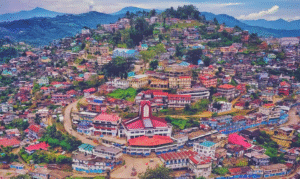Introduction
The diverse tribal communities of Northeast India possess rich and vibrant traditions, one of the most celebrated being their age-old handloom weaving practices. Weaving in this region is not merely a means of creating clothing but is a deeply embedded cultural act that symbolizes identity, heritage, and storytelling. Among the many communities known for their weaving prowess, the Naga tribes of Nagaland, the Mizo people of Mizoram, and the Assamese communities of Assam stand out for their intricate techniques and elaborate textile designs.
This blog explores the traditional weaving practices of these communities, highlighting the historical, cultural, and symbolic significance of their handloom crafts. It also delves into the motifs, materials, colors, and processes that make their textiles unique, while reflecting on how these practices are preserved and promoted in the contemporary world.
I. Weaving as a Cultural Tradition
Weaving in Northeast India is largely a women-centric practice and often a domestic activity passed down through generations. In many households, girls learn to weave from a young age, gaining not just technical skills but also an understanding of the cultural significance of patterns and cloths. The woven fabrics often denote marital status, tribe, social rank, and even specific occasions.
Each community has developed distinct styles, motifs, and color schemes, making their textiles a visual representation of their heritage. The loom, in many households, holds a place of reverence, treated as a sacred object tied to feminine power, creativity, and continuity of tradition.
II. Naga Weaving Traditions
Historical and Cultural Context
Naga textiles are among the most recognizable in India due to their bold patterns, vibrant color contrasts, and symbolic motifs. Each Naga tribe—like the Ao, Angami, Sumi, and Lotha—has its own distinctive textile tradition, which acts as a visual identity marker. Historically, certain shawls and designs were reserved for warriors or community leaders who had achieved distinction in battle or leadership.
Design and Symbolism
Naga shawls are generally rectangular and woven using backstrap or loin looms. They often consist of three panels stitched together. The colors red, black, and white dominate Naga textiles, each bearing specific meanings:
- Red symbolizes courage and valor.
- Black represents the unknown, the night, or mourning.
- White often stands for purity and peace.
The Tsungkotepsu, a ceremonial shawl of the Ao tribe, is adorned with motifs like mithuns, spears, stars, and other symbols representing status and bravery. The motifs are not random; they are cultural codes that narrate stories of clan history, victory, and belief systems.
Tools and Techniques
Naga weavers primarily use the backstrap loom, which is portable and simple, allowing the weaver to control the tension and pattern manually. Cotton was historically spun at home, but nowadays, mill-spun yarn is also used. Natural dyes from plants, bark, and flowers were common before synthetic dyes became accessible.
III. Mizo Weaving Traditions
Cultural Relevance
In Mizoram, weaving is not just a household activity but a marker of Mizo identity and femininity. Traditional Mizo attire, such as the puan, is an essential component of social and religious events. Each puan design has its name and significance, and the handwoven cloth is an expression of the weaver’s skill and imagination.
Key Textiles and Patterns
One of the most revered textiles is the Puanchei, worn by Mizo women during festive dances and ceremonies. It features bright colors—predominantly red with intricate black and white patterns. The stripes and bands of color are methodically arranged, and the weaving often includes delicate supplementary weft techniques.
Other notable puans include:
- Puanlaisen – A red-and-white textile associated with dignity.
- Ngotekherh – Characterized by dark stripes on a white base, often worn by both genders.
- Hmaram – A design shared with the Hmar community, reflecting intertribal cultural sharing.
Looms and Innovations
Mizo women traditionally use the loin loom, much like the Nagas. The weaving is intensive and requires precise coordination between hand and eye. Over time, many weavers have adapted to frame looms for larger production, but the loin loom remains deeply respected for its authenticity and tradition.
The state of Mizoram has supported weaving through cooperatives and exhibitions, ensuring that young Mizo women learn and take pride in their textile traditions. Weaving has thus become both a cultural responsibility and a sustainable livelihood.
IV. Assamese Weaving Traditions
The Essence of Assamese Weaving
Assamese weaving is perhaps the most widely recognized across India due to the popularity of the mekhela chador and gamusa. Weaving is considered a divine craft in Assamese culture, and women who weave are highly respected. The region of Sualkuchi, also known as the “Manchester of Assam,” is a famous handloom hub, renowned for producing high-quality silk fabrics.
Types of Textiles
Assamese weavers work with three types of indigenous silk:
- Muga silk – Golden-hued and exclusive to Assam.
- Eri silk – Warm and textured, often used in winter clothing.
- Pat silk – Bright white and smooth, commonly used for ceremonial wear.
The mekhela chador is the traditional attire of Assamese women, consisting of two pieces draped around the body. The motifs used in these weaves are drawn from nature—flowers, creepers, animals, and geometric shapes dominate. Each pattern has a poetic name, such as butidar (flower-filled) or japi motif (after the traditional bamboo hat).
Techniques and Symbolism
The jacquard technique is used for intricate weaving. Assamese textiles are known for their subtle elegance, with motifs often woven in contrasting colored silk threads. The gamusa, a rectangular cotton cloth, is deeply symbolic in Assamese culture. It is used during Bihu, for rituals, and as a mark of respect.
Looms used in Assamese weaving are typically frame looms, which are more elaborate than the loin looms of Nagaland and Mizoram. Women have historically dominated this craft, often weaving in their courtyards or dedicated loom rooms in homes.
V. Comparing Weaving Practices Across Communities
Despite regional and cultural differences, weaving traditions among the Naga, Mizo, and Assamese communities share certain core values:
- Cultural Identity – Textiles are deeply symbolic and linked with the community’s social structure, values, and belief systems.
- Matrilineal Knowledge Transfer – Women are the primary custodians of weaving knowledge.
- Natural Influence – Nature is a recurring theme across motifs, dye sources, and color preferences.
- Manual Precision – The emphasis is on handloom weaving, with meticulous attention to detail and pattern accuracy.
What distinguishes them are the materials, types of looms, and symbolic motifs:
- Naga textiles often denote warrior achievements and tribe-based identities.
- Mizo puans express femininity, ceremony, and intertribal harmony.
- Assamese weaves reflect elegance, natural motifs, and spiritual undertones.
VI. Preservation and Contemporary Relevance
In recent decades, the rise of machine-made fabrics and synthetic alternatives posed a threat to traditional weaving. However, renewed interest in sustainable fashion, slow living, and cultural heritage has revitalized handloom traditions.
Designers across India are collaborating with weavers from these communities to create contemporary garments rooted in tradition. Government schemes, NGOs, and cultural festivals—like the Hornbill Festival in Nagaland and the Assam Handloom Festival—have played a crucial role in promoting these crafts.
Educational institutions and museums are also documenting weaving practices, ensuring that these intangible cultural heritages are preserved for future generations.
Conclusion
Traditional weaving practices among the Naga, Mizo, and Assamese communities are not just artistic expressions—they are embodiments of cultural history, identity, and continuity. Each thread carries a story, and every motif is a symbol of pride, resilience, and memory. In a rapidly modernizing world, these weaving traditions stand as gentle reminders of the wisdom and beauty in preserving heritage through hands that weave and hearts that remember.






